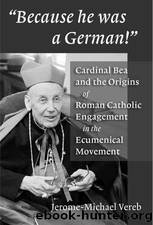Because He Was a German!: Cardinal Bea and the Origins of Roman Catholic Engagement in the Ecumenical Movement by Jerome-Michael Vereb

Author:Jerome-Michael Vereb [Jerome-Michael Vereb]
Language: eng
Format: epub
Published: 2008-09-28T19:26:00+00:00
Tardini's response was immediate and enthusiastic: "Si! Un Concilio! "23
The topic of conversation according to Flamini was that, in the midst of complexities of Cold War politics, religion was failing, and that to combat growing indifference, not only the Catholic Church but all Christian Churches needed to seek ways to bring back freshness to Christianity. According to John, the idea of a council was "Un Balzo Inavanti" [A Leap Forward]. Therefore, only five days later, in the presence of a handful of Cardinals, Pope John proclaimed the Council in the Basilica of St. Paul's Outside the Walls at the conclusion of the Week of Church Unity Octave, as it was then called, on the feast of the Conversion of St. Paul, zs January.24
From its inception in r9o8, the Occasion of Church Unity Octave presented the world with a concept of ecumenism. For many, there was confusion between "return" or "reunion." At the time of Pope John's proclamation of the Council, it was still not yet clear. The public events of 11959 were to be about world unity, the urgency of which was clear, against the terrifying threats of the Cold War. On that occasion, without eliminating his themes, John effectively conveyed a message of unity. Political commentators Roland Flamini and Giancarlo Zizola believed that the political crisis between East and West weighed heavily upon the shoulders of the pontiff, along with his sensitivity to a growing relaxation into secularism, agnosticism, and even atheism in Europe. Both Cardinal Willebrands and Archbishop Capovilla confirmed for the author viva voce that the above inter pretation is correct. Pope John was to confirm his message about unity in even more explicit terms on 29 June 11959, with the encyclical Ad Petri Cathedram (At the Chair of Peter). Pope John would, it seems, grow into a more precise theological focus upon reunion in the remainder of his pontificate, as will be evident on the occasion of the visit of the Archbishop of Canterbury in late 1960.25
Download
This site does not store any files on its server. We only index and link to content provided by other sites. Please contact the content providers to delete copyright contents if any and email us, we'll remove relevant links or contents immediately.
| Military | Political |
| Presidents & Heads of State | Religious |
| Rich & Famous | Royalty |
| Social Activists |
Waking Up in Heaven: A True Story of Brokenness, Heaven, and Life Again by McVea Crystal & Tresniowski Alex(37676)
Empire of the Sikhs by Patwant Singh(22980)
We're Going to Need More Wine by Gabrielle Union(18973)
Hans Sturm: A Soldier's Odyssey on the Eastern Front by Gordon Williamson(18489)
Leonardo da Vinci by Walter Isaacson(13189)
The Radium Girls by Kate Moore(11930)
Tools of Titans by Timothy Ferriss(8226)
Educated by Tara Westover(7947)
How to Be a Bawse: A Guide to Conquering Life by Lilly Singh(7394)
Permanent Record by Edward Snowden(5743)
The Last Black Unicorn by Tiffany Haddish(5560)
The Rise and Fall of Senator Joe McCarthy by James Cross Giblin(5230)
Promise Me, Dad by Joe Biden(5089)
The Wind in My Hair by Masih Alinejad(5034)
A Higher Loyalty: Truth, Lies, and Leadership by James Comey(4851)
The Crown by Robert Lacey(4731)
The Iron Duke by The Iron Duke(4294)
Joan of Arc by Mary Gordon(4022)
Stalin by Stephen Kotkin(3883)
